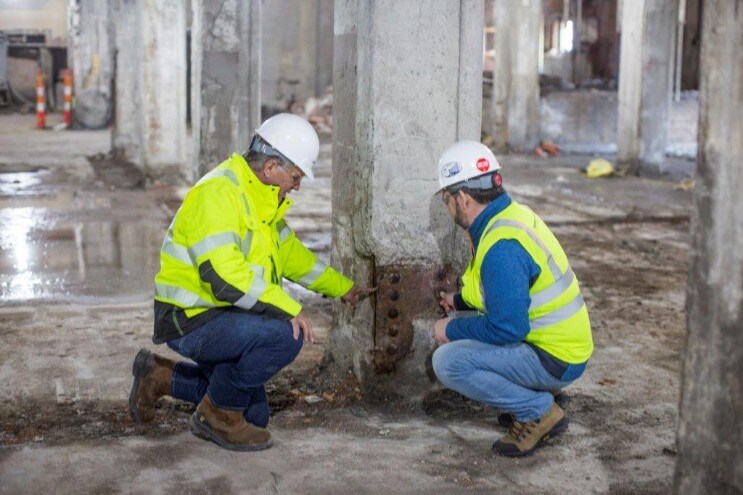Michigan Central Station’s Masonry, Steel Structure Are The Focus Of Second Phase Of Construction
May 23, 2019
DETROIT, May 23, 2019 – Ford announced today that the second phase of construction at Michigan Central Station is underway, including restoring eight acres of masonry and repairing the steel structure of the historic Beaux-Arts building. The masonry repairs are the most labor and time intensive part of the restoration project and will continue into 2021.
Scaffolding will be erected around the 15-floor tower, beginning in June, followed by the Grand Lobby in the fall. Workers will spend the next two to three years removing bricks to fix the steel framework that sits behind, then cleaning, repointing and replacing the damaged terracotta, limestone and brick that make up the station’s exterior.
Ford began the three-phase renovation project in December as part of its plan to make Michigan Central Station the centerpiece of a new innovation hub in Corktown that will bring together employees and other partners, entrepreneurs and businesses to shape the future of mobility.
The first phase of construction involved winterizing, drying out and securing the 640,000-square-foot train station to begin reversing 30 years of extensive water damage and decay. Workers installed temporary roofing and plumbing systems; to date, they have removed 227,000 gallons of water from the building. The building will continue to dry out naturally over the next few years, with temporary heating added in the fall to help the process.
“We’ve made huge strides in the first 6-months of construction thanks to the multiple contractors and teams onsite who are working together to get the job done correctly and safely,” said Richard Bardelli, Ford’s construction manager for the project. “Their hard work and collaboration is making a complicated job a whole lot easier.”
Up next: Checking the steel structure and preserving the historic features
With most of the winterization and stabilization work completed, the construction team is ready to start fixing the steel structure and repairing the extensive masonry on the tower, waiting room and concourse.
The band of steel around the top of the 240-foot-tall structure will also go under inspection. Workers will remove 1,200 feet of cornice, a decorative molding around the top edge of the building, to examine the steel behind it and make repairs. Terracotta cornices will be replaced and 106,000 square feet of roof structure repairs will be completed in this second phase of construction.
Additionally, 1,184 tower windows will be restored to preserve the station’s historic appearance.
Returning the waiting room to its original grandeur
In addition to the exterior work, masonry repairs inside the building will focus on the Guastavino tile vaulted ceiling in the former waiting room. One of the train station’s most impressive features, it is made up of 22,000 square feet of clay tiles covering three self-supporting arches.
“Despite having had no roof for decades, the Guastavino ceiling is in surprisingly good shape which is testament to its superior craftsmanship,” said Bardelli. “We installed a temporary roof to protect the arches from further deterioration and we will now be working to install a new copper roof.”
Ford plans to clean all of the restorable Guastavino tiles and replace others. The company has already made an initial order of 5,000 tiles from one of the few manufacturers capable of replicating this important feature. Interior scaffolding will go up early next year to make the repair work possible.
Other artisan work in the former waiting room, concourse and arcade will be taken down and restored or replicated. This includes extensive plaster work and ornamental pieces that decorated the walls and marble columns that were removed during the building’s abandonment.
Original drawings and blueprints will be used to make molds to replicate the decorative pieces. The construction team is working with Ford’s advanced engineering team to explore 3D modeling to replicate unique plaster ornamentation.
The final phase of construction will entail finishing and restoring the interior to get it ready for tenants in 2022 when the station opens to the public once again.
About Ford Motor Company
Ford Motor Company (NYSE: F) is a global company based in Dearborn, Michigan. The company designs, manufactures, markets and services a full line of Ford trucks, utility vehicles, and cars – increasingly including electrified versions – and Lincoln luxury vehicles; provides financial services through Ford Motor Credit Company; and is pursuing leadership positions in electrification; mobility solutions, including self-driving services; and connected vehicle services. Ford employs approximately 186,000 people worldwide. For more information regarding Ford, its products and Ford Motor Credit Company, please visit corporate.ford.com.


